非线性延迟微分方程被广泛应用于生物学、物理学、医学、自动化等学科[1-5]。振动性作为一种重要的定性行为,在生物数学和工业等领域有一些很好的应用[6-8]。自上世纪70年代起,就有学者开始研究各种非线性延迟微分方程的振动性[9-12]。1825年,Gompertz[13]在探讨人类死亡规律时首次提出了Gompertz方程后Winsor[14]和Laird等[15]对该数学模型进行了修改并提出了一些在肿瘤方面的应用,后来越来越多的学者对Gompertz型方程的性质[16-19]与应用[20-22]展开了大量的研究。
2011年,Piotrowska等[16]提出了几类带延迟项的Gompertz方程,并研究了延迟项对经典Gompertz方程的影响,2013年,Bodnar等[17]在其基础上又引入了一项用于反映种群变化过程的外部干扰,并研究了方程的Hopf分支。在此基础上,考虑式(1)和式(2)的延迟Gompertz方程。
| $\dot V(t) = - rV(t - \tau )\ln \frac{{V(t - \tau )}}{k} - TV(t - \tau ),t \geqslant 0$ | (1) |
| $ \dot V(t) = - rV(t)\ln \frac{{V(t - \tau )}}{k} - TV(t - \tau ),t \geqslant 0 \;\;\;\;\;\;$ | (2) |
其中
| $ V(t) = \varphi (t),{\kern 1pt} {\kern 1pt} {\kern 1pt} {\kern 1pt} - \tau \leqslant t \leqslant 0 $ | (3) |
其中
定义1[23] 设
定义2[23] 若
定义3[23] 若方程(1)的所有解都是振动的,则称方程(1)是振动的。
定理1[23] 考虑微分方程
| $ \dot x(t) + px(t) + qx(t - \tau ) = 0 $ | (4) |
其中
定理2[23] 考虑差分方程
| $ {a_{n + 1}} - {a_n} + \sum\limits_{i = - k}^l {{q_i}{a_{n + i}} = 0} $ | (5) |
其中
定理3[23] 考虑差分方程
| $ {a_{n + 1}} - {a_n} + p{a_{n - k}} + q{a_{n - l}} = 0 $ | (6) |
其中
| $p\frac{{{{{\rm{(k + 1}})}^{k + 1}}}}{{{k^k}}} > {{{(1 + q}})^{k + 1}}$ |
则称方程(6)的所有解都是振动的。
引理1[24] 设
(1)若
引理2 若
引理3 若
定理4 若
| $ \tau (r + T){{\rm{e}}^{ - T\tau }} > \frac{1}{{\rm{e}}} $ | (7) |
则方程(1)所有的解关于稳定点
证明设
| $k\dot x(t){{\rm{e}}^{x(t)}} = - rk{\rm{e}^{x(t - \tau )}}x(t - \tau ) - Tk{{\rm{e}}^{x(t - \tau )}}$ |
化简得
| $\begin{array}{*{20}{l}} {\dot x(t) = - rx(t - \tau ){{\rm{e}}^{x(t - \tau ) - x(t)}} - T{{\rm{e}}^{x(t - \tau ) - x(t)}}}\\ {\dot x(t) = {{\rm{e}}^{x(t - \tau ) - x(t)}}( - rx(t - \tau ) - T)} \end{array}$ |
利用泰勒公式得其极限方程为
| $ \dot x(t) = Tx(t) - (r + T)x(t - \tau ) - T\qquad \quad\;\;\; $ | (8) |
再做变换,令
| $\dot y(t) = T\left( {y(t) - \frac{T}{r}} \right) - (r + T)\left( {y(t - \tau ) - \frac{T}{r}} \right) - T$ |
化简得
由定理1知,当式(7)成立时,方程(9)所有的解是振动的,故方程(1)所有的解也是振动的。
定理5 若式(7)成立,则方程(2)所有的解关于稳定点
证明 设
化简得
利用泰勒公式得其极限方程(8),后面证明过程同定理4。
接下来通过分析方程(9)的数值解的振动性,从而得出方程(1)和方程(2)数值解振动的充分条件。用线性θ方法对方程(9)进行离散,并得出其数值解的振动的条件。
令
| $\tag{10}\begin{split}{V_{n + 1}} =& {V_n} + h\theta {V_{n + 1 - m}}\left( - r\ln \displaystyle\frac{{{V_{n + 1 - m}}}}{k} - T\right) + \\& h(1 - \theta ){V_{n - m}}\left( - r\ln \displaystyle\frac{{{V_{n - m}}}}{k} - T\right)\end{split} $ | (10) |
| $\tag{11}\begin{array}{l}\displaystyle{V_{n + 1}}\left( {1 + h\theta r\ln \frac{{{V_{n + 1 - m}}}}{k}} \right) = {V_n}\left( {1 - h(1 - \theta )r\ln \frac{{{V_{n - m}}}}{k}} \right) - \\ \qquad \qquad \; \displaystyle T\left( {h\theta {V_{n + 1 - m}} + h(1 - \theta ){V_{n - m}}} \right)\\[-10pt]\end{array}$ | (11) |
| $\tag{12}\begin{aligned} {y_{n + 1}} = &{y_n} + h\theta T{y_{n + 1}} - h\theta (r + T){y_{n + 1 - m}} + h(1 - \theta )T{y_n} - \\ &h(1 - \theta )(r + T){y_{n - m}} \\[-10pt]\end{aligned} $ | (12) |
式(12)经过变换,得
| $\tag{13} \begin{split} {y_{n + 1}} = &\frac{{1 + h(1 - \theta )T}}{{1 - h\theta T}}{y_n} - \frac{{h\theta (r + T)}}{{1 - h\theta T}}{y_{n + 1 - m}} - \quad \;\;\;\; \\ & \frac{{h(1 - \theta )(r + T)}}{{1 - h\theta T}}{y_{n - m}} \end{split} $ | (13) |
引理4 方程(12)的特征方程是
| $\tag{14} \lambda = R\left( {h(T - (r + T){\lambda ^{ - m}})} \right) $ | (14) |
其中
证明 令
化简得
| $\lambda = 1 + h\theta T\lambda - h\theta (r + T){\lambda ^{1 - m}} + h(1 - \theta )T - h(1 - \theta )(r + T){\lambda ^{ - m}}$ |
计算得
| $( {1 - h\theta (T - (r + T){\lambda ^{ - m}})} )\lambda = 1 + h(1 - \theta )(T - (r + T){\lambda ^{ - m}})$ |
即
| $\begin{aligned}\lambda = \frac{{1 + h(1 - \theta )(T - (r + T){\lambda ^{ - m}})}}{{1 - h\theta (T - (r + T){\lambda ^{ - m}})}} = R(h(T - (r + T){\lambda ^{ - m}}))\end{aligned}$ |
得证。
引理5 若
证明 不妨令
| $\tag{15} R\left( {h(T - (r + T){\lambda ^{ - m}})} \right) \leqslant \exp \left( {h(T - (r + T){\lambda ^{ - m}})} \right) $ | (15) |
令
且有
上式两边同乘
| $\tau (r + T){{\rm{e}}^{1 - T\tau }}\lambda _0^m \leqslant \tau (r + T){{\rm{e}}^{1 - T\tau }}\exp ( {\tau ( {T - (r + T)\lambda _0^{ - m}} )} )$ |
化简得
| $\tag{17} \tau (r + T){{\rm{e}}^{1 - T\tau }} \leqslant \tau (r + T)\lambda _0^{ - m}\exp ( {1 - \tau (r + T)\lambda _0^{ - m}} ) $ | (17) |
如果
| $\tau (r + T){{\rm{e}}^{ - T\tau }} \leqslant {1}/{{\rm{e}}}$ |
这与式(7)矛盾。
如果
| $\exp ( {1 - \tau (r + T)\lambda _0^{ - m}} ) \leqslant 1/\tau (r + T)\lambda _0^{ - m}$ |
即有
| $\tau (r + T)\lambda _0^{ - m}\exp ( {1 - \tau (r + T)\lambda _0^{ - m}} ) \leqslant 1$ |
又由式(16)得
| $\tau (r + T)\exp ( {( {1 - \tau (r + T)\lambda _0^{ - m}} ) - T\tau + \tau (r + T)\lambda _0^{ - m}} ) \leqslant 1$ |
化简得
即
这与式(7)矛盾。
故对任意的
下文讨论
引理6 假设
| $\tag{18} {h_0} = \left\{ {\begin{array}{*{20}{l}} {\infty ,}&{(r + T) \geqslant 1}\\ {\displaystyle\frac{{\tau \left( {\ln (r + T)\tau + 1 - T\tau } \right)}}{{1 - T\tau + T\tau \ln (r + T)\tau }},}&{(r + T) < 1} \end{array}} \right. $ | (18) |
证明当
| $\begin{array}{c} R\left( {h(T - (r + T){\lambda ^{ - m}})} \right) = \displaystyle\frac{{1 + h(1 - \theta )(T - (r + T){\lambda ^{ - m}})}}{{1 - h\theta (T - (r + T){\lambda ^{ - m}})}} \leqslant \\ \displaystyle\frac{1}{{1 - h(T - (r + T){\lambda ^{ - m}})}}\end{array} $ |
接下来证明不等式
| $\tag{19} \lambda - \frac{1}{{1 - h(T - (r + T){\lambda ^{ - m}})}} > 0,{\kern 1pt} {\kern 1pt} {\kern 1pt} {\kern 1pt} \lambda > 0 $ | (19) |
在一定条件下成立。
| $\begin{aligned} &\qquad\qquad\qquad \lambda - \frac{1}{{1 - h(T - (r + T){\lambda ^{ - m}})}} = \\ &\frac{{\lambda - \lambda h(T - (r + T){\lambda ^{ - m}}) - 1}}{{1 - h(T - (r + T){\lambda ^{ - m}})}} \!=\! \frac{{\lambda - \lambda hT - 1 + h(r + T){\lambda ^{1 - m}}}}{{1 - h(T - (r + T){\lambda ^{ - m}})}} \!= \\ & \frac{{{\lambda ^m}(1 \!\!-\!\! hT){\lambda ^{1 \!-\! m}} \!\!-\!\! {\lambda ^{1\! - \!m}}(1 \!\!-\!\! hT)\displaystyle\frac{{{\lambda ^{m \!-\! 1}}}}{{1 \!\!-\!\! hT}} + {\lambda ^{1 \!-\! m}}(1 \!\!-\!\! hT)\displaystyle\frac{{h(r \!\!+\!\! T)}}{{1 \!\!-\!\! hT}}}}{{1 \!\!-\!\! h(T - (r \!\!+\!\! T){\lambda ^{ \!-\! m}})}}= \\ & \frac{{\left( {1 - hT} \right){\lambda ^{1 - m}}}}{{1 - h(T - (r + T){\lambda ^{ - m}})}}\left( {{\lambda ^m} - \frac{1}{{1 - hT}}{\lambda ^{m - 1}} + \frac{{h(r + T)}}{{1 - hT}}} \right) \end{aligned}$ |
设
| ${y_{n + 1}} - {y_n} - \frac{{hT}}{{1 - hT}}{y_n} + \frac{{h(r + T)}}{{1 - hT}}{y_{n + 1 - m}} = 0$ |
的特征多项式。由定理2和定理3可知,
已知
| $\begin{array}{l} \ln (r \!+\! T)\tau \!+\! (m \!-\! 1)\ln \displaystyle\frac{m}{{m - 1}} \!-\! \ln (1 \!- hT) \!>\! m\ln (1 \!+\! \displaystyle\frac{{hT}}{{1 - hT}})\\ \ln (r \!+\! T)\tau \!+\! (m \!-\! 1)\ln \displaystyle\frac{m}{{m - 1}} - \ln (1 \!-\! hT) > - m\ln (1 - hT) \\ \end{array} $ |
即
| $\ln (r + T)\tau + (m - 1)\left( {\ln \frac{m}{{m - 1}} + \ln (1 - hT)} \right) > 0$ |
从而有
若
| $\begin{array}{c}\ln (r + T)\tau + (m - 1)\ln \left( {1 + \displaystyle\frac{{1 - T\tau }}{{m - 1}}} \right) > \\\ln (r + T)\tau + \displaystyle \frac{{(m - 1)(1 - T\tau )}}{{m - T\tau }}\end{array} $ |
现证
| $\begin{array}{c}\ln (r + T)\tau + \displaystyle \frac{{(\tau - h)(1 - T\tau )}}{{\tau - hT\tau }} = \\ \displaystyle \frac{{(\tau - hT\tau )\ln (r + T)\tau + (\tau - h)(1 - T\tau )}}{{\tau (1 - hT)}} > 0\end{array} $ |
即证
| $\tau \ln (r + T)\tau + \tau (1 - T\tau ) > hT\tau \ln (r + T)\tau + h(1 - T\tau )$ |
即
| $h < \frac{{\tau \left( {\ln (r + T)\tau + 1 - T\tau } \right)}}{{1 - T\tau + T\tau \ln (r + T)\tau }}$ |
从而证明不等式(20)成立。
综上得知对任意的
| $\begin{aligned} f(\lambda ) =& \lambda - R\left( {h(T - (r + T){\lambda ^{ - m}})} \right) \geqslant \\ & \lambda - \exp (h(T - (r + T){\lambda ^{ - m}})) > 0 \end{aligned} $ |
即特征方程(14)无正根。
由引理5和引理6,可得如下方程(1)和方程(2)的数值解的振动性结论。
定理6 当
这一部分将举例验证前文所证得的结果。前3个例子验证方程(1)的相关结论,后3个例子用于验证方程(2)的相关结论。其中
首先给出方程(1)中
| $\tag{21}\left\{ \begin{array}{l} \dot V(t) = - \displaystyle\frac{1}{3}V(t - 2)\ln \displaystyle\frac{{V(t - 2)}}{5} - \displaystyle\frac{1}{3}V(t - 2),{\kern 1pt} {\kern 1pt} {\kern 1pt} t \geqslant 0 \\ \phi (t) = 1,{\kern 1pt} {\kern 1pt} {\kern 1pt} {\kern 1pt} - 2 \leqslant t \leqslant 0 \\ \end{array} \right.\\[-10pt] $ | (21) |
在方程(21)中,易知
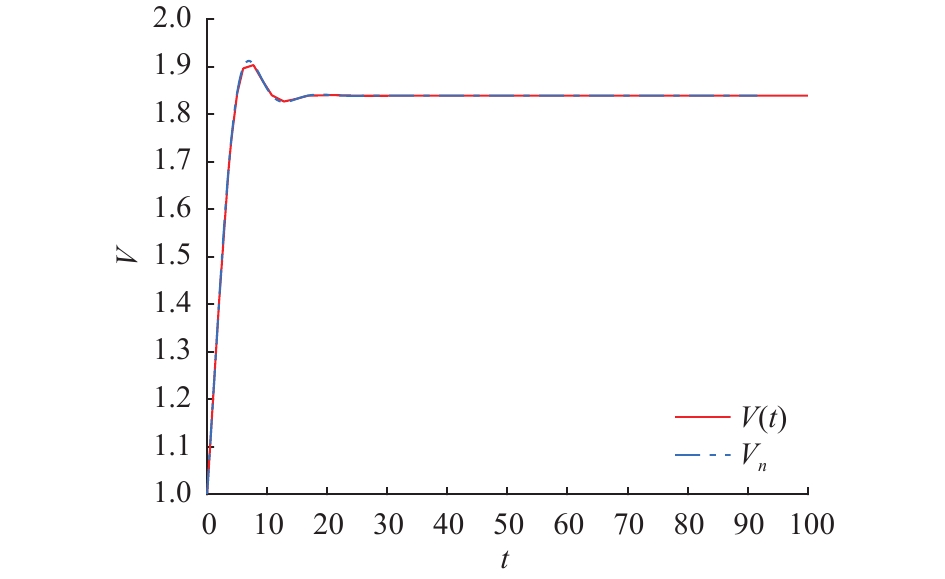
|
图 1 方程(21)的解析解
|
讨论方程(1)中
| $\tag{22}\left\{ \begin{array}{l} \dot V(t) = - 2V(t - \displaystyle{1}/{6})\ln \displaystyle\frac{{V(t - \displaystyle{1}/{6})}}{3} - 2V(t - \displaystyle{1}/{6}),{\kern 1pt} {\kern 1pt} {\kern 1pt} t \geqslant 0 \\ \phi (t) = 20, - 1/6 \leqslant t \leqslant 0 \\ \end{array} \right. $ | (22) |
由方程(22)得
| $h < {h_0} = \frac{{\tau \left( {\ln (r + T)\tau + 1 - T\tau } \right)}}{{1 - T\tau + T\tau \ln (r + T)\tau }} \approx 0.081\;9$ |
方程(22)的数值解也是关于平衡点
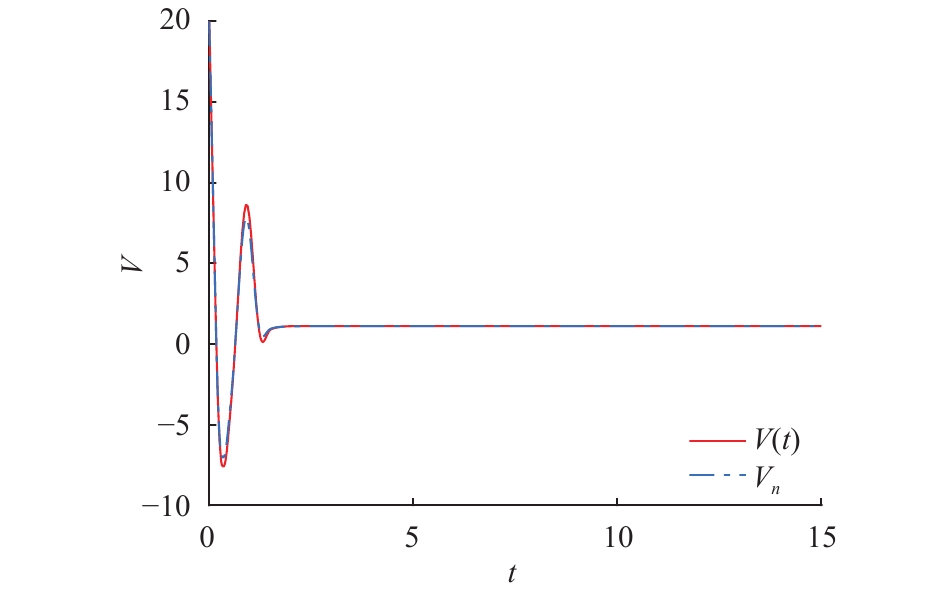
|
图 2 方程(22)的解析解
|
考虑方程(23)
| $\tag{23}\left\{\begin{array}{l} \dot V(t) = - 4V(t - 0.4)\ln \displaystyle\frac{{V(t - 0.4)}}{7} - \displaystyle\frac{2}{{17}}V(t - 0.4),{\kern 1pt} {\kern 1pt} {\kern 1pt} t \geqslant 0 \\ \phi (t) = 9, - 0.4 \leqslant t \leqslant 0 \\ \end{array} \right. $ | (23) |
在方程(23)中,易得知
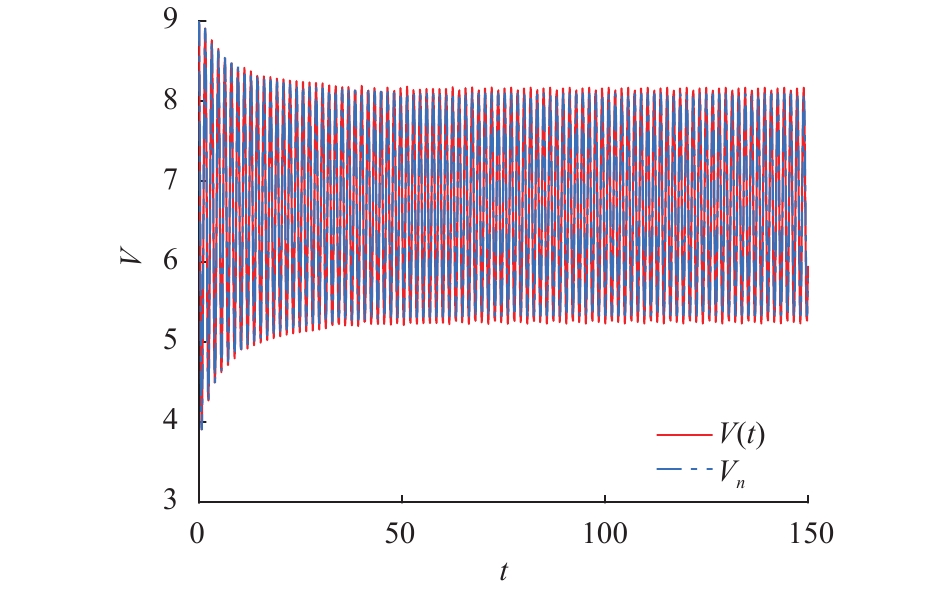
|
图 3 方程(23)的解析解
|
下文的例子将验证方程(2)的振动相关理论。首先给出方程(2)中
| $\tag{24}\left\{ \begin{array}{l} \dot V(t) = - 3V(t)\ln \displaystyle\frac{{V(t - 1/6)}}{5} - 2V(t - 1/6),{\kern 1pt} {\kern 1pt} {\kern 1pt} t \geqslant 0 \\ \phi (t) = 10, - 1/6 \leqslant t \leqslant 0 \\ \end{array} \right. $ | (24) |
在方程(24)中可知
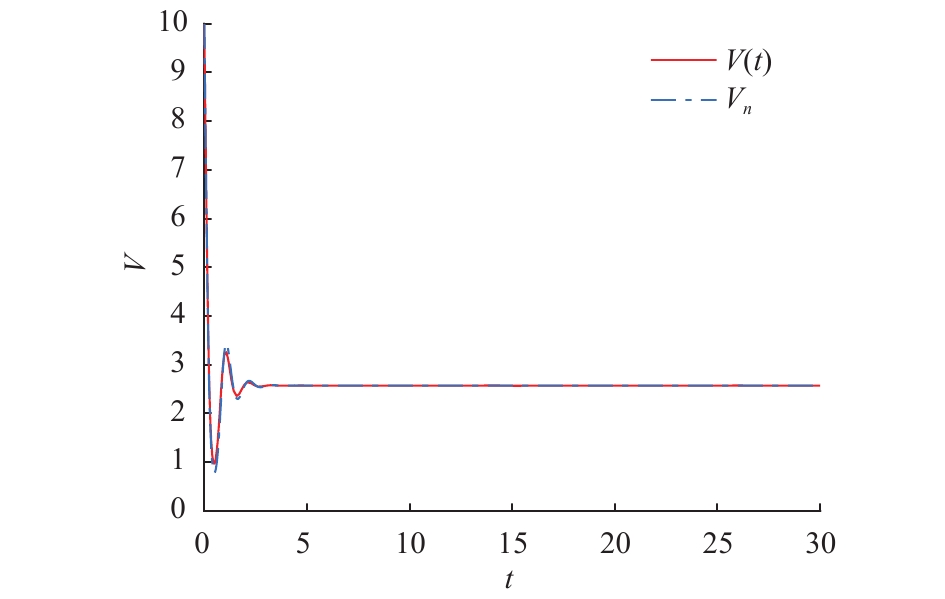
|
图 4 方程(24)的解析解
|
然后给出方程(2)中
| $\tag{25}\left\{ \begin{array}{l} \dot V(t) = - \displaystyle\frac{1}{4}V(t)\ln \displaystyle\frac{{V(t - 2.5)}}{9} - \frac{1}{5}V(t - 2.5),{\kern 1pt} {\kern 1pt} {\kern 1pt} t \geqslant 0 \\ \phi (t) = 6, - 2.5 \leqslant t \leqslant 0 \\ \end{array} \right. $ | (25) |
在方程(25)中,易知
| $h < {h_0} = \frac{{\tau \left( {\ln (r + T)\tau + 1 - T\tau } \right)}}{{1 - T\tau + T\tau \ln (r + T)\tau }} \approx 2.763\;4$ |
方程(25)的数值解也是关于平衡点
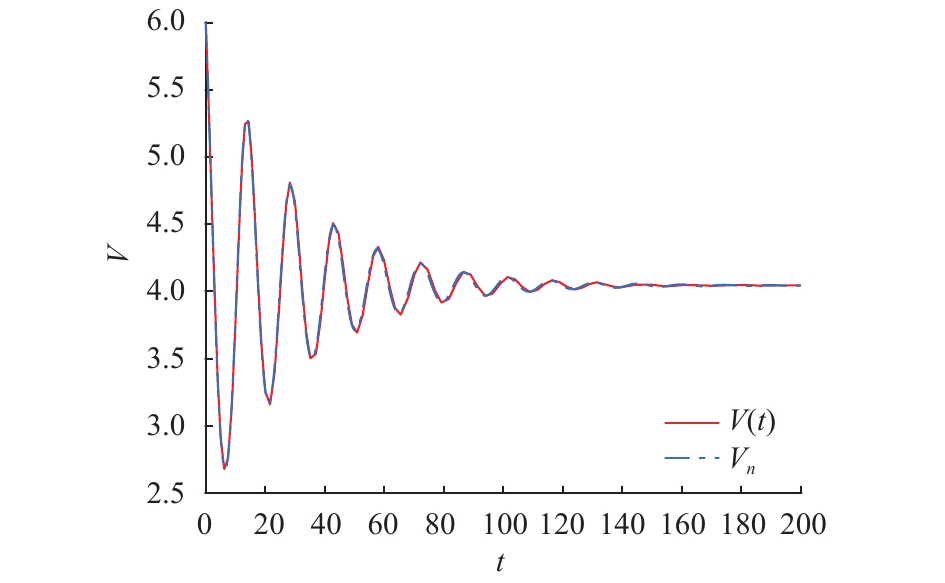
|
图 5 方程(25)的解析解
|
考虑方程(26)
| $\tag{26}\left\{ \begin{array}{l} \dot V(t) = - \displaystyle\frac{1}{{11}}V(t)\ln \displaystyle\frac{{V(t - 10)}}{2} - \displaystyle\frac{1}{6}V(t - 10),{\kern 1pt} {\kern 1pt} {\kern 1pt} t \geqslant 0 \\ \phi (t) = 12, - 10 \leqslant t \leqslant 0 \\ \end{array} \right. $ | (26) |
在方程(26)中,易知
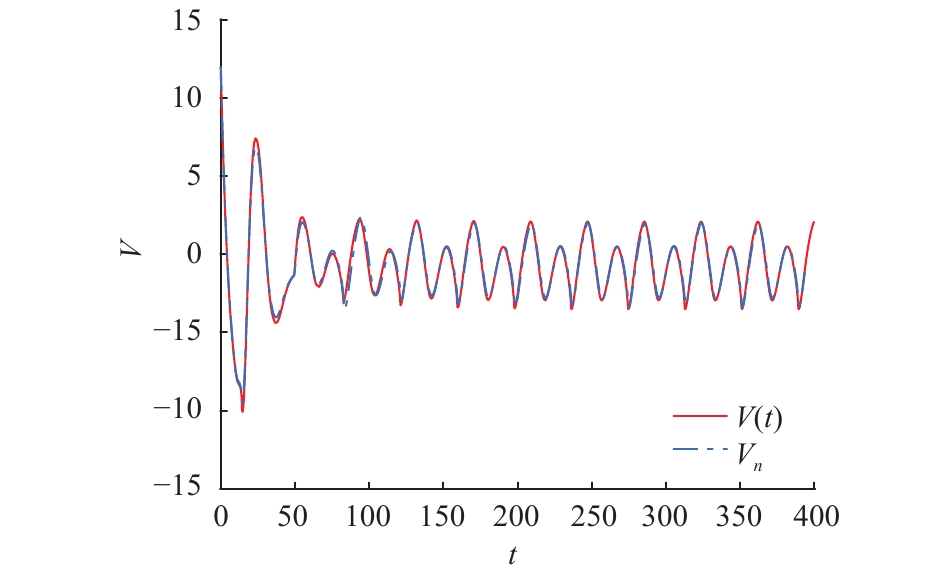
|
图 6 方程(26)的解析解
|
| [1] |
HUANG M G, LUO J W, HU L C, et al. Assessing the efficiency of Wolbachia driven Aedes mosquito suppression by delay differential equations[J].
Journal of Theoretical Biology, 2018, 440: 1-11.
DOI: 10.1016/j.jtbi.2017.12.012. |
| [2] |
MISRA A K, RAI R K, TAKEUCHI Y. Modeling the effect of time delay in budget allocation to control an epidemic through awareness[J].
International Journal of Biomathematics, 2018, 11(2): 53-62.
|
| [3] |
SONG P F, XIAO Y N. Global hopf bifurcation of a delayed equation describing the lag effect of media impact on the spread of infectious disease[J].
Journal of Mathematical Biology, 2018, 76(5): 1249-1267.
DOI: 10.1007/s00285-017-1173-y. |
| [4] |
LIU H J, ZHANG J F. Dynamics of two time delays differential equation model to HIV latent infection[J].
Physica A: Statistical Mechanics and Its Applications, 2019, 514: 384-395.
DOI: 10.1016/j.physa.2018.09.087. |
| [5] |
RAMEH R B, CHERRY E M, SANTOS R W. Single-variable delay-differential equation approximations of the Fitzhugh-Nagumo and Hodgkin-Huxley models[J].
Communications in Nonlinear Science and Numerical Simulation, 2020, 82: 105066-105077.
DOI: 10.1016/j.cnsns.2019.105066. |
| [6] |
MITRA R K, BANIK A K, DATTA T K, et al. Nonlinear roll oscillation of semisubmersible system and its control[J].
International Journal of Non-Linear Mechanics, 2018, 107: 42-55.
DOI: 10.1016/j.ijnonlinmec.2018.10.006. |
| [7] |
HU B, DIAO X, ZONG L Q, et al. The onset mechanism of Parkinson’s beta oscillations: a theoretical analysis[J].
Journal of Theoretical Biology, 2019, 470: 1-16.
DOI: 10.1016/j.jtbi.2019.03.008. |
| [8] |
GRACE S R, GRAEF J R, JADLOVSKÁ I. Oscillation criteria for second-order half-linear delay differential equations with mixed neutral terms[J].
0Mathematica Slovaca, 2019, 69(5): 1117-1126.
DOI: 10.1515/ms-2017-0294. |
| [9] |
宋福义, 高建芳. 一类非线性延迟微分方程数值解的振动性分析[J].
应用数学学报, 2016, 39(5): 762-773.
SONG F Y, GAO J F. Oscillation analysis of numerical solutions for a kind of nonlinear delay differential equation[J]. Acta Mathematicae Applicatae Sinica, 2016, 39(5): 762-773. |
| [10] |
GAO J F. Numerical oscillation and non-oscillation for differential equation with piecewise continuous arguments of mixed type[J].
Applied Mathematics and Computation, 2017, 299: 16-27.
DOI: 10.1016/j.amc.2016.11.031. |
| [11] |
SANTRA S S. Necessary and sufficient conditions for oscillation to second-order half-linear delay differential equations[J].
Journal of Fixed Point Theory and Applications, 2019, 21(3): 85.
DOI: 10.1007/s11784-019-0721-z. |
| [12] |
WANG Q, WEN J C, ZHANG P. Oscillation analysis of advertising capital model: analytical and numerical studies[J].
Applied Mathematics and Computation, 2019, 354: 365-376.
DOI: 10.1016/j.amc.2019.02.029. |
| [13] |
GOMPERTZ B. On the nature of the function expressive of the law of human mortality, and on the new mode of determining the value of life contingencies[J].
Philosophical Transactions of The Royal Society of London, 1825, 115: 513-585.
DOI: 10.1098/rstl.1825.0026. |
| [14] |
WINSOR C P. The Gompertz curve as a growth curve[J].
Proceedings of The National Academy of Sciences, 1932, 18(1): 1-8.
DOI: 10.1073/pnas.18.1.1. |
| [15] |
LAIRD A K, TYLER S A, BARTON A D. Dynamics of normal growth[J].
Growth, 1965, 29(3): 233-248.
|
| [16] |
PIOTROWSKA M J, FORYŚ U. The nature of Hopf bifurcation for the Gompertz model with delays[J].
Mathematical & Computer Modelling, 2011, 54(9-10): 2183-2198.
|
| [17] |
BODNAR M, PIOTROWSKA M J, FORYŚ U. Gompertz model with delays and treatment: mathematical analysis[J].
Mathematical Biosciences and Engineering (Online), 2013, 10(3): 551-563.
DOI: 10.3934/mbe.2013.10.551. |
| [18] |
CABRALES L E B, MONTIJANO J I, SCHONBEK M, et al. A viscous modified gompertz model for the analysis of the kinetics of tumors under electrochemical therapy[J].
Mathematics and Computers in Simulation, 2018, 151: 96-110.
DOI: 10.1016/j.matcom.2018.03.005. |
| [19] |
宋继志, 王媛媛. 延迟Gompertz模型的数值分支和混合控制[J].
河北科技大学学报, 2019, 40(2): 112-118.
SONG J Z, WANG Y Y. Numerical bifurcation and hybrid control of a Gompertz model with time delay[J]. Journal of Hebei University of Science and Technology, 2019, 40(2): 112-118. |
| [20] |
LEDZEWICZ U, MUNDEN J, SCHÄTTLER H. Scheduling of angiogenic inhibitors for Gompertzian and logistic tumor growth models[J].
Discrete and Continuous Dynamical Systems-Series B (DCDS-B), 2012, 12(2): 415-438.
|
| [21] |
ENDERLING H, CHAPLAIN M A J. Mathematical modeling of tumor growth and treatment[J].
Current Pharmaceutical Design, 2014, 20(30): 4934-4940.
DOI: 10.2174/1381612819666131125150434. |
| [22] |
LEDZEWICZ U, MAURER H, SCHÄTTLER H. Optimal and suboptimal protocols for a mathematical model for tumor anti-angiogenesis in combination with chemotherapy[J].
Mathematical Biosciences and Engineering (Online), 2017, 8(2): 307-323.
|
| [23] |
GYÖRI I, LADAS G. Oscillation theory of delay differential equations[M]. Oxford: Clarendon Press, 1991.
|
| [24] |
SONG M H, YANG Z W, LIU M Z. Stability of θ-methods for advanced differential equations with piecewise continuous arguments
[J].
Computers & Mathematics with Applications, 2005, 49(9-10): 1295-1301.
|
 2020, Vol. 37
2020, Vol. 37

